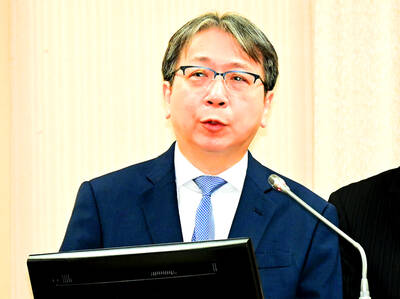China began commercial flights along its controversial M503 air route yesterday morning, with six international flights employing it, the Civil Aeronautics Administration (CAA) said.
No “abnormal movements” were detected along the route, the Mainland Affairs Council (MAC) said yesterday.
Critics say the new route — unilaterally announced by Beijing — is too close to Taiwan’s airspace.
Council officials said they would continue monitoring the route and take appropriate measures to protect Taiwan’s national security.
The establishment of the new route in China’s Shanghai flight information region sparked national security concerns, as part of it is just 7.8km from the median line of the Taiwan Strait. The Strait’s median line is the de facto boundary between Taiwan and China.
CAA records from yesterday showed that six flights had used the route as of 11:30am, with five of them departing from Shanghai Pudong Airport and one leaving from Qindao.
Of the Shanghai flights, four were Dragonair trips to Hong Kong, and one was a Malaysia Airlines flight to Kuala Lumpur. The one leaving from Qingdao was a China Eastern Airlines flight to Hong Kong.
The CAA said that none of these flights deviated from the route and maintained altitudes of 31,000 feet (9,449m) or above.
The agency said that 16 airline companies have applied to use the route, adding that the number of daily flights should not exceed 30.
Beijing had planned to start sending commercial aircraft along the route on March 5.
Due to a fierce reaction from the Taiwanese public, China and Taiwan engaged in cross-strait negotiations. China postponed the launch of the route to yesterday and agreed to move it to the west by 6 nautical miles (11km).
In a report to the legislature on Thursday last week, National Security Bureau Director-General Lee Shying-jow (李翔宙) said that the modified commercial route — now slightly closer to China than originally planned — would leave Taiwan with considerable leeway to react to any potential air attacks and would reduce China’s own patrol areas for Chinese fighter jets in the Taiwan Strait.
In other news, the CAA yesterday said it would announce its new aviation safety bulletin today, asking all domestic airlines to amend their safety management procedures by requiring that there be at least two members of the flight crew in the cockpit at all times during flights.
It added that it would conduct inspections to determine whether airlines observe the new rule.
Prior to the announcement, most domestic airlines announced over the weekend that they would start enforcing the rule following the crash of Germanwings Flight 4U9525 on Tuesday last week.
French air accident investigators released some evidence from the cockpit voice recorder on Thursday that seemed to show the pilot was locked out of the cockpit during the flight and that the copilot was alone inside the cockpit before the fatal crash occurred.

The US government has signed defense cooperation agreements with Japan and the Philippines to boost the deterrence capabilities of countries in the first island chain, a report by the National Security Bureau (NSB) showed. The main countries on the first island chain include the two nations and Taiwan. The bureau is to present the report at a meeting of the legislature’s Foreign Affairs and National Defense Committee tomorrow. The US military has deployed Typhon missile systems to Japan’s Yamaguchi Prefecture and Zambales province in the Philippines during their joint military exercises. It has also installed NMESIS anti-ship systems in Japan’s Okinawa

‘WIN-WIN’: The Philippines, and central and eastern European countries are important potential drone cooperation partners, Minister of Foreign Affairs Lin Chia-lung said Minister of Foreign Affairs Lin Chia-lung (林佳龍) in an interview published yesterday confirmed that there are joint ventures between Taiwan and Poland in the drone industry. Lin made the remark in an exclusive interview with the Chinese-language Liberty Times (the Taipei Times’ sister paper). The government-backed Taiwan Excellence Drone International Business Opportunities Alliance and the Polish Chamber of Unmanned Systems on Wednesday last week signed a memorandum of understanding in Poland to develop a “non-China” supply chain for drones and work together on key technologies. Asked if Taiwan prioritized Poland among central and eastern European countries in drone collaboration, Lin

TRAGEDY STRIKES TAIPEI: The suspect died after falling off a building after he threw smoke grenades into Taipei Main Station and went on a killing spree in Zhongshan A 27-year-old suspect allegedly threw smoke grenades in Taipei Main Station and then proceeded to Zhongshan MRT Station in a random killing spree that resulted in the death of the suspect and two other civilians, and seven injured, including one in critical condition, as of press time last night. The suspect, identified as a man surnamed Chang Wen (張文), allegedly began the attack at Taipei Main Station, the Taipei Fire Department said, adding that it received a report at 5:24pm that smoke grenades had been thrown in the station. One man in his 50s was rushed to hospital after a cardiac arrest

ON ALERT: Taiwan’s partners would issue warnings if China attempted to use Interpol to target Taiwanese, and the global body has mechanisms to prevent it, an official said China has stationed two to four people specializing in Taiwan affairs at its embassies in several democratic countries to monitor and harass Taiwanese, actions that the host nations would not tolerate, National Security Bureau (NSB) Director-General Tsai Ming-yen (蔡明彥) said yesterday. Tsai made the comments at a meeting of the legislature’s Foreign Affairs and National Defense Committee, which asked him and Minister of National Defense Wellington Koo (顧立雄) to report on potential conflicts in the Taiwan Strait and military preparedness. Democratic Progressive Party (DPP) Legislator Michelle Lin (林楚茵) expressed concern that Beijing has posted personnel from China’s Taiwan Affairs Office to its